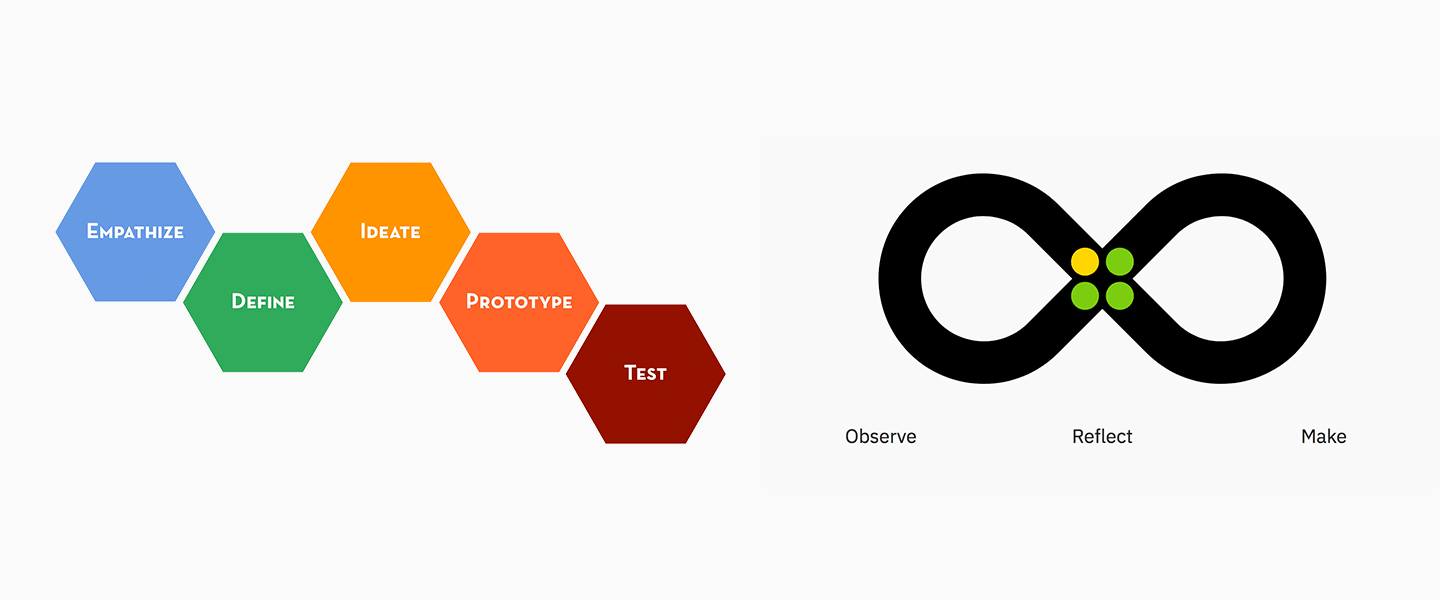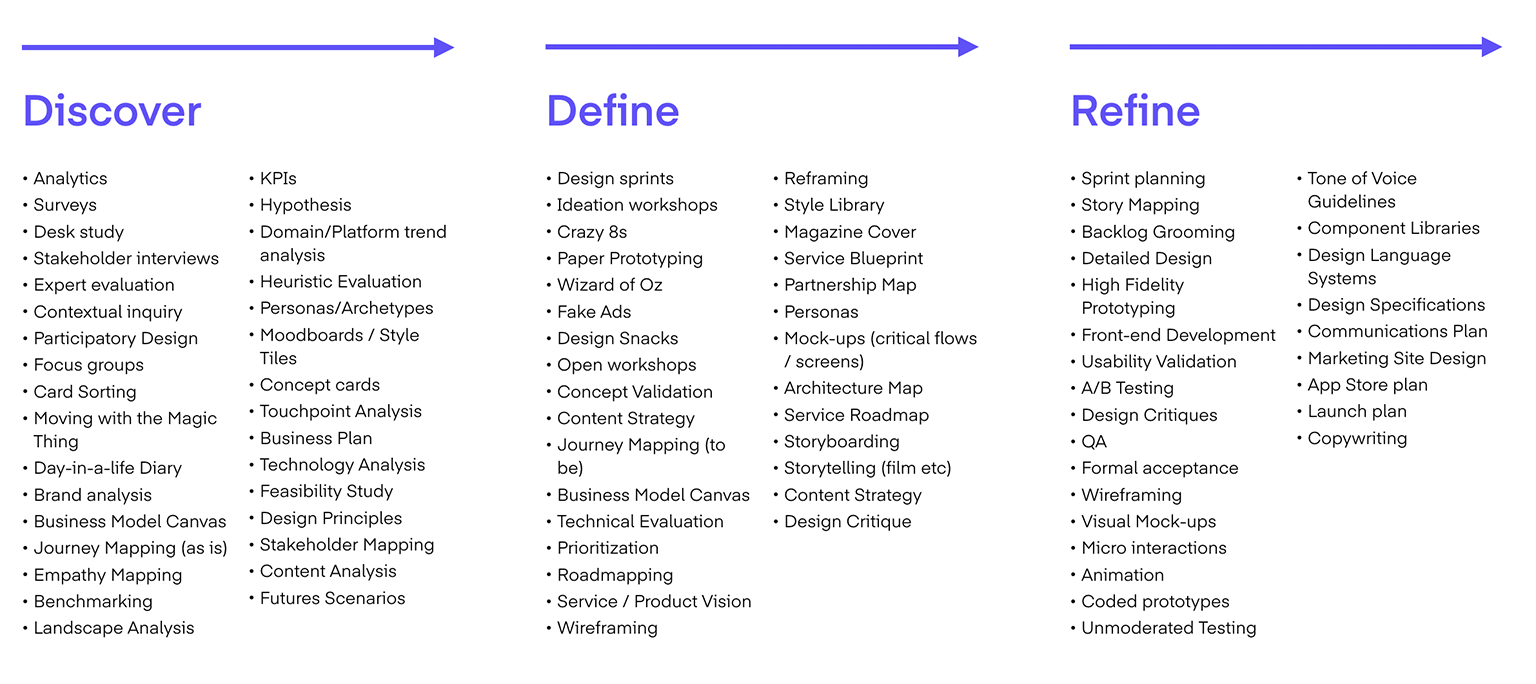
Spreading design thinking in large organizations
If you are reading this, it is likely you are already familiar with the concept of design thinking. You’ve likely read about it, applied the principles in your own work, and maybe even tried speaking up for practicing the mindset at scale within your company.
You’re convinced. You’ve seen the benefits. But now what?
How do you spread the human-centered, experimental, and co-creative way of working within large organizations?
Throughout history, all influential movements have spread through the hard work, vision, and motivation of courageous individuals. For a movement to start gaining followers, you always need those bold pioneers who are willing to lead by example, craft the shared vision, and put themselves on the line to gain momentum — to drive change. The classic Dancing Guy video is all the proof one needs.
Still, no matter how amazing your moves, it takes more than movements to cross the chasm between a few bold individuals’ visions and mainstream acceptance. Based on our experience in helping numerous large companies ramp up their design thinking practices, we at Idean crafted a framework to support the evangelists and forerunners in making the movement happen. In addition to helping our clients, we use this framework as a starting point for planning workshops around the topic, most recently at the Design Systems Conference in Helsinki.

The guiding light illuminating why this is important and what our unique approach is

The practical applications from our process, including the tools and methods we use

Sharing the knowledge and supporting your first followers

The structure and activities that give us momentum and keep us on the right track
Vision & principles
Establishing a common vision and principles will help you lead with a shared understanding instead of pushing for ready-made solutions.
When people are empowered to craft their own solutions based on commonly established principles, they are far more motivated to succeed than when merely executing someone else’s orders. To enable this, we emphasize the need to understand your audience, to co-create, and to document in way that inspires.

Understand who you are trying to influence and how
By definition, a shared understanding is not something you can dictate from an ivory tower. Instead, alignment is a collaborative effort. To achieve this alignment, one of the first things to do is to understand who the stakeholders are that you’d like to impact—and what kind of a change in behavior or attitudes are you seeking from them?
Once you have an understanding of who these people are, you are in a better position to involve the ones who matter the most. And, together, you can craft principles that will help guide you forward.
Co-create shared principles
To craft a set of principles that people can stand behind, it helps to host workshops that invite everyone to contribute and think by doing. This is far more productive than having long discussions where, unfortunately, it’s often the loudest, the highest paid, or the most extroverted whose voices are heard.
Your goal for these workshops is to involve your key stakeholders—and, together, create a vision that you can all sign off on and are excited to start working toward. Some common tasks for such workshops include creating mock magazine covers or tweets from the future, illustrating what success would look like and what you are striving to achieve.
Document your unique language
After arriving at a shared understanding of what it is you want to achieve, the principles should be documented as a part of your organization’s unique design language. This language is your shared vocabulary, your documentation of lessons learned, and your collection of signposts that guide you forward. Essentially, it is the formal — yet inspiring — documentation of what you are setting out to achieve through design, and how you will get there.
Depending on your company’s culture and goals, your design language might be built to emphasize different types of principles:
What is the end-user experience we seek: outcome-oriented principles that consider what the benefit is to the end user. One example is Google’s material design guidelines.
How they should be created: process-oriented principles that guide how you work with a design thinking mindset. One example is IBM’s design thinking principles.
 Material is the metaphor Material is the metaphor |
 Bold, graphic, intentional Bold, graphic, intentional |
 Motion provides meaning Motion provides meaning |

Some companies combine both process- and outcome-oriented principles in their design language — it really depends on what your context is and what change you set out to achieve.
Shared practices
Introducing shared practices allows you to drive change through everyday actions.
While it is difficult to approach a task so abstract and large as changing an entire organization, influencing seemingly small, everyday practices is a much more concrete starting point. These practices include your design process and your preferred methods and tools. They ensure that you have a common starting point and a frame of reference so you don’t have to reinvent the wheel with every new initiative.
The design process
The design process is the 10,000-foot view of how human-centered design is practiced in your organization. The most famous examples are the d.School and Double Diamond models. Overall, all design process visualizations describe much of the same thing: empathizing with your end users, defining the problem worth solving, ideating for solutions, rapid prototyping, and testing your ideas out in the real world in an iterative manner.
To make the model easier to communicate—and to make it your own—it pays off to build a custom description of the process for your specific context. For example, IBM’s process is described as an infinity loop, emphasizing that design is a continuous process; whereas SAP’s process description outlines clear checkpoints along three major phases. Each organization’s custom design process is based on the same ideas, but reflects their unique culture, terminology, and struggles.

On the left, the d.School model, which is one of the most widely used in the industry. On the right, IBM’s loop, a custom approach to fit their own particular context and purposes.
Methods and tools
Methods and tools are the more detailed activities that help people apply design thinking in their everyday work. They consist of research methods such as contextual interviews, synthesis methods like journey mapping, ideation methods including crazy 8s, prototyping methods such as wizard of oz, and countless others. In fact, there are so many methods out there that someone new to the world of design is likely to find the sheer amount of methods confusing. Building a curated, approachable toolkit customized for your organization’s needs will help alleviate the information overload, and will help you approach complex problem-solving tasks in a structured and more consistent manner.

The amount of tools out there is insane. Without creating a pre-curated list of tools, these are likely to hinder more than help in getting new people to try these useful methods out.
When defining the process, tools, and methods that best fit your organization’s needs, one aspect to still consider is how these manifest themselves as tangible artifacts: Will you print a book? Build a website? Revamp your working space? Create cat memes? Once again, a question of context. And budget. And cojones.
Communication & training
Engaging communication and hands-on training are essential for bringing the design transformation to reality.
Through communication and training, your goal is to increase people’s understanding of design thinking, and move them from utter ignorance toward awareness, and eventually toward practicing design thinking in their daily work. Some will even become fellow evangelists, and will support you in spreading the movement.

The adoption journey from awareness to evangelism.
In communication and training, there are five core aspects we emphasize:
Make it unexpected
Grab people’s attention with distinctive communications. For example, Visa, inspired by the concept of hackathons, hosted internal Design-a-thons to give people the opportunity to personally experience the design thinking approach in a single-day event. Whatever it is in your context, make your idea stand out.
Present it in a simple package
Focus on the core and package it in a way that is simple enough to grasp. For example, Google Venture’s sprint model is packaged so well that even without understanding the details, the value and process is easy for anyone to grasp: By following the process, you’ll get results in one week.
Make it concrete
Aim to make your actions so apparent and visible that it is hard for anyone to miss. From printing large-scale journey maps to running live user tests with low-fidelity prototypes, you can increase awareness by making yourself visible in locations that people walk by on a daily basis. For example, project rooms with walls covered in Post-it notes always raise interest, and anything near the coffee machine is likely to provoke spontaneous discussions.
Learn by doing
Once people become aware of the approach you are promoting and are drawn to the idea, they will need mentoring in applying the approach in their daily work. For example, Cargotec built an accelerator program where teams can explore and validate new business opportunities in a guided manner during a 10-week period.
Identify and support your torchbearers
For your idea to gain traction, you will need to ensure that the early adopters — the ones that are willing to follow your approach even with no guarantee of mainstream success — are empowered to share the message. The spreading of this new idea is likely to somewhat follow the diffusion of innovation curve, and especially when you first get started, you should focus your energy on convincing the people who will help you take the message forward.
Eventually, the only way to really understand what design thinking is about is by experiencing it yourself, which is why workshops and guided programs are often the best way to gain initial traction. While online trainings can be cost effective, live workshops are the most intensive way of experiencing the design thinking way, and getting practice to later applying it in your own work.
Program management
Endless planning is easy to get stuck in. Plans will change, and you should have a bias toward action. Figure out the first step, and get started. Then keep realigning your approach as you go along.

There is no one correct way to get started, but many potential paths to success.
For managing the internal dynamics within large organizations, there are five activities we have recognized that will make your journey easier:
Start a spearhead project
There are many ways to get started on your journey, but the recommended approach is to start a spearhead project, in which you will apply the design thinking process and methods in practice. This will allow you to build the first case study that can act as the success story in your communications. And you will gain a ton of valuable learnings along the way.
Secure executive support
You need the support of the top management to make an influence on the company level. As soon as possible, focus energy on finding an executive who shares your mindset, or is curious enough about your experiment to support your efforts.
Co-create your vision
Get your core stakeholders in the same room to work on your vision together. Using collaborative workshop methods, you can try and spark a reaction to your initial ideas, or help people envision the change.
Set up a governance model
A governance model is about guidance and accountability. It is about inspiring the change, managing the process of constant learning, securing a budget, and proving the results to your organization.
Gather quantifiable outcomes
Design thinking, like anything, can be quantified. The ROI of design thinking is often measured on market positioning, customer loyalty, relevance of your offering, internal capability development, or speed to market.
Final remarks
In the words of Indira Gandhi:
Have a bias toward action — let’s see something happen now. You can break that big plan into small steps and take the first step right away.
As final remarks to light your way, there are five suggestions we recommend you keep in mind when getting started:
1) Don’t waste time with non-believers, you will never reach everyone. 2) Focus investments into projects that are staffed to succeed. 3) Start small, but be bold. 4) Finding your own path takes time and experimentation. 5) Embrace and support your first followers; they will make the movement with you.
Get started, gain empathy, experiment, and iterate as you go.
Contributors
Written by: Anna Kalme
Content by: Matias Vaara, Sampo Jalasto, Petri Heiskanen, Anna Kalme
About Idean: We help businesses — from startups to Fortune 500 companies — create the most innovative and valuable services, products, and experiences in their industries. We specialize in customer experience, user experience, user interface, and service design. In addition to designing and shipping cutting-edge digital products and services, we also help businesses establish world-class design programs that ignite growth and improve customer experience at an organizational level.

frog, part of Capgemini Invent is a global design and innovation firm. We transform businesses at scale by creating systems of brand, product and service that deliver a distinctly better experience. We strive to touch hearts and move markets. Our passion is to transform ideas into realities. We partner with clients to anticipate the future, evolve organizations and advance the human experience.
We respect your privacy
We use Cookies to improve your experience on our website. They help us to improve site performance, present you relevant advertising and enable you to share content in social media. You may accept all Cookies, or choose to manage them individually. You can change your settings at any time by clicking Cookie Settings available in the footer of every page. For more information related to the Cookies, please visit our Cookie Policy.